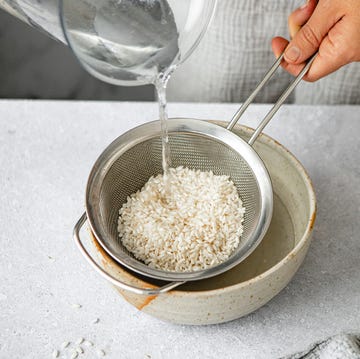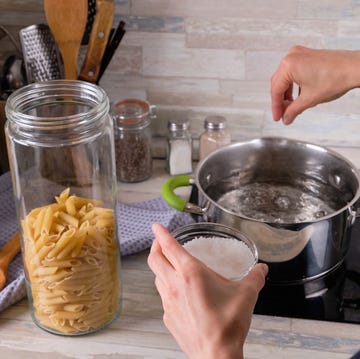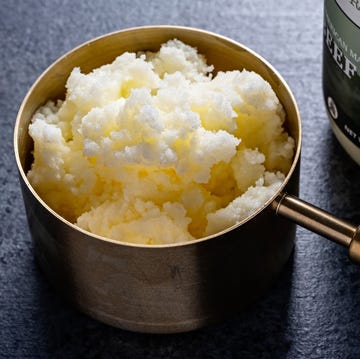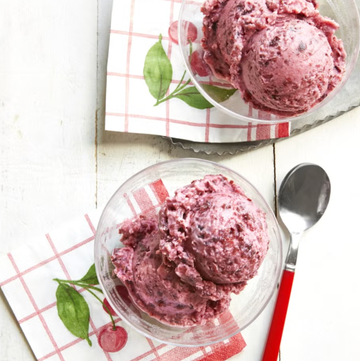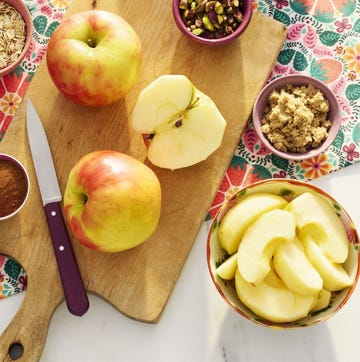1American Cheese
 Getty Images
Getty ImagesAmerican cheese is made with a blend of varieties, including cheddar and Colby. It also contains milk byproducts that make it supremely melty while keeping it from separating or turning greasy like other cheeses might. That's what makes it the classic burger topping!
SHOP SLICERS
2Asiago
 Getty Images
Getty ImagesAn Italian cow's milk cheese, Asiago can be found in two varieties: pressed or ripened. Pressed asiago has semi-soft, creamy texture with a sweet and nutty flavor. This is the kind you'll most likely find sliced and placed on charcuterie boards. Ripened asiago is aged, harder, and saltier. It's more like parmesan and can be grated to top things like pastas and salads.
Advertisement - Continue Reading Below
3Blue
 Getty Images
Getty ImagesYou either love blue cheese or avoid it at all costs. It has a sharp, salty, funky flavor! The secret to this cheese's pungent taste is actually a strain of mold called penicillium that is injected into cheese made with cow's, sheep's or goat's milk before it is aged. You can find it in many varieties, including French Roquefort cheese made with sheep's milk, Italian gorgonzola, and Stilton, an English blue cheese.
4Brie
 Getty Images
Getty ImagesRich, buttery, and deliciously creamy, brie has an edible rind and smooth, soft middle. This type of cheese is typically made with cow's milk. In fact, cream is added during the production process to make it even more rich and luxurious. It is scrumptious chilled, but baked brie is also fantastic, especially when topped with honey and herbs.
Advertisement - Continue Reading Below
5Camembert
 Eric AUDRAS//Getty Images
Eric AUDRAS//Getty ImagesCamembert and brie share a lot of similarities, but these two French cheeses have their differences, too. Camembert has a richer, bolder flavor and is denser than mild, runny brie. With big buttery, mushroom notes, it's scrumptious spread on crusty bread.
SHOP CUTTING BOARDS
6Cheddar
 Roberto Machado Noa//Getty Images
Roberto Machado Noa//Getty ImagesA cow's milk cheese that originally hailed from England, cheddar is insanely popular in the United States. Young cheddars are milk and creamy while aged cheddars have a stronger, more complex flavor and crumbly texture. The most interesting thing about cheddar, though, is how it's made: Once the curds are separated from the whey, the curds go through a "cheddaring" process where they are broken up to expel air and liquid before being stacked and pressed together to age.
Advertisement - Continue Reading Below
7Cotija
 snyferok//Getty Images
snyferok//Getty ImagesThis strongly tangy, salty cheese comes from the Mexican state of Michoacán. It has a rich, milky texture, but this cheese doesn't melt. That's why it's almost exclusively used as a topping or garnish on things like salads, enchiladas, tacos, and elote (aka Mexican street corn).
8Cottage Cheese
 burwellphotography//Getty Images
burwellphotography//Getty ImagesCottage cheese has been having a moment lately, and it's about time. This fresh cheese has a mild, milky flavor and is protein-packed. Cottage cheese is made by adding acid to pasteurized cow's milk which causes the curds and whey to separate. The curds are rinsed, (sometimes) salted, and packaged.
Advertisement - Continue Reading Below
9Cream Cheese
 annick vanderschelden photography//Getty Images
annick vanderschelden photography//Getty ImagesSmeared onto a bagel or whipped into your favorite party dip, cream cheese is a smooth, creamy, fresh cheese that's a staple in many American homes. This cheese was invented by a New York state dairyman in the 1870s. He used a combination of milk and cream in his cheese-making process. Once the whey is drained off, the curds are stabilized and pureed, resulting in the cream cheese we know and love. Similarly, Boursin is essentially a French cream cheese that is flavored with herbs and spices.
10Edam
 Songbird839//Getty Images
Songbird839//Getty ImagesThis semi-hard Dutch cheese is made using sweet curds from part-skim milk, meaning no acid is used so that the natural sweetness of the milk comes through. It's sealed in edam's signature red or black wax and has a slightly sweet and nutty flavor along with a smooth, soft texture. Babybels are a French version of edam cheese.
SHOP CHEESE KNIVES
Advertisement - Continue Reading Below
11Feta
 etiennevoss//Getty Images
etiennevoss//Getty ImagesA soft Greek cheese made traditionally from sheep's milk, feta can also be made using goat or cow's milk. This salty, briny cheese is known for its rich, creamy texture that will soften when heated, but won't melt.
12Fontina
 Fabrizio_Esposito//Getty Images
Fabrizio_Esposito//Getty ImagesTraditional Fontina cheese is from the northwest of Italy. However, other countries like Denmark, Sweden and the United States have started to make their own fontinas from cow's milk. Like other cheeses, younger fontinas are sweeter and more mild in flavor with a smoother texture—perfect for grilled cheese and casseroles. Older fontinas are drier and more crumbly, and they're delicious grated or shaved over a variety of dishes, including salads, risottos, pastas and soups.
Advertisement - Continue Reading Below
13Goat
 Westend61//Getty Images
Westend61//Getty ImagesGoat cheese is just that—cheese made from goat's milk. It is generally softer than cheese made from cow's milk and far more tangy, due to the presence of fatty acids that give goat cheese its unique flavor.
14Gouda
 tpzijl//Getty Images
tpzijl//Getty ImagesOne of the oldest cheeses on record, this Dutch classic dates back as far as 1184. It is a semi-hard cheese typically made from cow's milk and is known for its springy texture and rich, caramelized flavor. Younger goudas make for a pleasant table cheese; older goudas will be more crystallized looking, and tend to have a deep, nutty, buttery flavor.
Advertisement - Continue Reading Below
15Grana Padano
 Westend61//Getty Images
Westend61//Getty ImagesGrana Padano is Italy's most produced cheese—nearly 24% of the country's cow's milk production is reserved for this household staple. It's made with part-skim milk and matures faster than Parmigiano-Reggiano, which is made with a mixture of part-skim and whole milk and takes a minimum of 12 months to mature. Grana Padano is packed with flavor and is a great grating cheese—it's also naturally lactose-free, thanks to its production process.
SHOP CHEESE GRATERS
16Gruyère
 PicturePartners//Getty Images
PicturePartners//Getty ImagesA true Swiss cheese, gruyère is a firm cow's milk cheese named after the town where it was originally made. It's a favorite table cheese, perfect for any cheese board, but it's also beloved for its melting properties. Gruyère is the gold standard when preparing fondue and it is also the cheese used to make French Onion Soup and croque monsieur.
Advertisement - Continue Reading Below
17Halloumi
 etiennevoss//Getty Images
etiennevoss//Getty ImagesIf you've ever wanted to actually grill cheese, pick up some halloumi on your next grocery store run. A Cypriot cheese made traditionally from goat and/or sheep's milk, halloumi is similar to mozzarella in texture (squeaky and bouncy), though it's tangier and saltier in flavor. It can be eaten raw, but halloumi is most often reserved for cooking or grilling, as its exterior browns and crisps up nicely while holding in a soft, melted interior.
18Havarti
 BWFolsom//Getty Images
BWFolsom//Getty ImagesThis Danish cheese is the result of a female cheese-maker's quest in the mid-1800s to make an ultra-creamy, semi-firm cheese. Featuring a smooth and creamy yet mild flavor, havarti is often sold seasoned with other herbs and spices, like dill and caraway seeds.
Advertisement - Continue Reading Below
19Manchego
 annick vanderschelden photography//Getty Images
annick vanderschelden photography//Getty ImagesSpain's most popular cheese, manchego is made from sheep's milk in the La Mancha region, just south of Madrid. This is not a cheese that melts well, so it's often served as tapas alongside bread, olives and Serrano ham or paired with a sweet quince paste known as membrillo.
20Mascarpone
 milanfoto//Getty Images
milanfoto//Getty ImagesEssentially an Italian version of cream cheese, mascarpone is best known for holding all the layers together in tiramisu. It has nearly twice the butterfat of standard cream cheese, which means it basically melts in your mouth. Though slightly sweet in flavor, mascarpone can be used in savory dishes as well as sweet, similar to the versatility of cream cheese.
SHOP MEASURING SPOONS
Advertisement - Continue Reading Below
Advertisement - Continue Reading Below
Advertisement - Continue Reading Below



